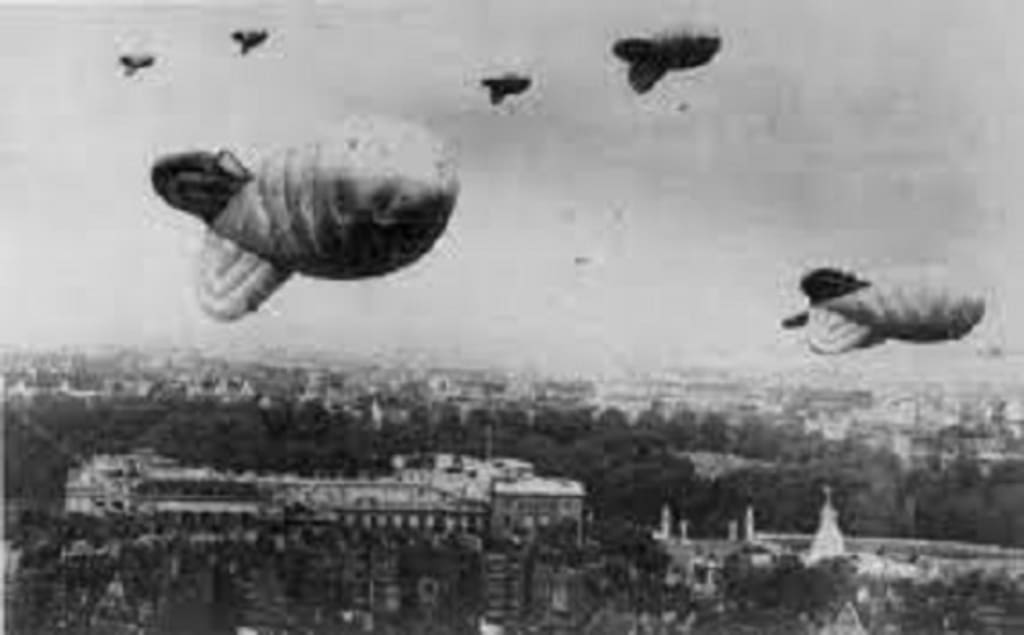Guardians of the Sky
The Comprehensive History of the British Balloon Command in World War II

In the crucible of World War II, as Britain braced itself against aerial threats, an unsung hero emerged in the form of the British Balloon Command. Established in 1938, this strategic force became the vanguard of Britain's airspace, deploying barrage balloons that crisscrossed the sky in a web of defense. As of the middle of 1940, the British Balloon Command boasted an impressive array of 1,400 balloons, interwoven with miles of steel cable and barrage netting. This article delves into the intricate details of the British Balloon Command, exploring its origins, the technology behind its defenses, and its pivotal role in thwarting aerial assaults, including the infamous V1 flying bomb.
The genesis of the British Balloon Command can be traced back to 1938, a time when the ominous clouds of war were gathering over Europe. Recognizing the imminent threat of aerial attacks, British military strategists conceived the idea of using barrage balloons as a defensive measure. The command was officially established to organize and deploy these balloons, heralding a new chapter in aerial defense tactics.
At the heart of the British Balloon Command's arsenal were barrage balloons, helium-filled behemoths tethered to the ground by steel cables. These balloons, strategically positioned across key locations, served as an imposing obstacle for enemy aircraft. The sheer number—1,400 balloons by mid-1940—underscored the magnitude of this aerial defense system, creating a formidable barrier against hostile incursions.
Complementing the barrage balloons were miles of steel cable and barrage netting, intricately woven into a skyward fortress. These elements were crucial in enhancing the effectiveness of the balloon defenses. The steel cables, when raised to a certain altitude, posed a significant hazard to low-flying enemy aircraft, potentially causing damage or forcing them to fly at higher, less accurate altitudes.
The British Balloon Command strategically deployed its defenses to safeguard key locations, including cities, military installations, and industrial centers. The sight of barrage balloons hovering over these areas became a symbol of resilience and determination. The strategic placement aimed not only to physically impede enemy aircraft but also to create psychological deterrence, instilling a sense of vulnerability in potential attackers.
As World War II unfolded, the effectiveness of the British Balloon Command became increasingly evident. The barrage balloons proved to be a formidable deterrent against conventional aircraft, hindering their maneuverability and accuracy. Moreover, the balloon defenses played a crucial role in countering the threat posed by the V1 flying bomb, a formidable weapon deployed by the Axis powers. The unpredictable nature of the V1, often referred to as the "buzz bomb" or "doodlebug," made the role of the British Balloon Command even more critical.
The success of the British Balloon Command was not merely a result of static defenses; it was also a testament to adaptability. As the nature of aerial threats evolved, so did the technology employed by the command. Continuous advancements in balloon design, cable strength, and deployment strategies ensured that the British Balloon Command remained at the forefront of aerial defense throughout the war.
Operating the barrage balloon defenses posed unique challenges to the personnel of the British Balloon Command. Harsh weather conditions, maintenance demands, and the constant threat of enemy attacks created a demanding operational environment. Yet, the men and women of the command persevered, their dedication and heroism often overshadowed by the more visible aspects of wartime narratives.
As the war drew to a close, the British Balloon Command's legacy was etched into the annals of military history. The command's contribution to the defense of Britain was significant, and its success paved the way for future developments in aerial defense systems. The post-war era saw the evolution of technology, and the lessons learned from the British Balloon Command influenced subsequent innovations in anti-aircraft measures.
The British Balloon Command, established in 1938 and standing tall with 1,400 balloons by the middle of 1940, played a crucial role in shaping the defense of Britain during World War II. From its strategic deployment of barrage balloons to the intricate network of steel cables and barrage netting, every element of this aerial defense system contributed to the safeguarding of the homeland. The legacy of the British Balloon Command endures as a testament to innovation, adaptability, and the unsung heroism of those who worked tirelessly to protect the skies over Britain during one of the darkest periods in modern history.
About the Creator
Enjoyed the story? Support the Creator.
Subscribe for free to receive all their stories in your feed. You could also pledge your support or give them a one-off tip, letting them know you appreciate their work.






Comments
There are no comments for this story
Be the first to respond and start the conversation.